
Prairie County is in the Central Arkansas region of the U.S. state of Arkansas. The county is named for the Grand Prairie, a subregion of the Arkansas Delta known for rice cultivation and aquaculture that runs through the county. Created as Arkansas's 54th county in 1846, Prairie County is home to four incorporated towns, including DeValls Bluff, the southern district county seat, and two incorporated cities, including Des Arc, the northern district county seat. The county is also the site of numerous unincorporated communities and ghost towns. Occupying 676 square miles (175,000 ha), Prairie County is the median-sized county in Arkansas. As of the 2010 Census, the county's population is 8,715 people in 4,503 households. Based on population, the county is the ninth-smallest county of the 75 in Arkansas.

Cotter High School (CHS) is a comprehensive public junior-senior high school for students in grades 7 through 12 located in Cotter, Arkansas, United States. It is the sole high school of Cotter School District. The teacher-student ratio is approximately 10:1. Cotter High School serves the cities of Cotter and Gassville.

The US Post Office–Medford Main is a historic post office at 20 Forest Street in Medford, Massachusetts. Built in 1937, it is a fine example of construction work funded by the Public Works Administration, a jobs program of the 1930s. It was listed on the National Register of Historic Places in 1986.

Buchanan County Court House in Independence, Iowa, United States was built in 1940. It was listed on the National Register of Historic Places in 2003 as a part of the PWA-Era County Courthouses of IA Multiple Properties Submission. The current structure is the third courthouse to house court functions and county administration.

Lockesburg Waterworks are a water storage and distribution facility at the junction of Hickory and Azalea Streets in Lockesburg, Arkansas. The facility consists of a water tower and three water storage sheds, of which the tower was built in 1936 with funding assistance from the Public Works Administration, a Depression-era works project. The older shed was built in 1945, and the second was built in 1990. The tower is a metal structure with four legs supported and stabilized by cross bracing, with a metal tank at the top which is sheltered by a conical roof. The oldest shed is a modest square brick structure at the center of the complex, while the 1990 shed is located at the southwest corner of the property.
The University of Arkansas Campus Historic District is a historic district that was listed on the National Register of Historic Places on September 23, 2009. The district covers the historic core of the University of Arkansas campus, including 25 buildings.

The Des Moines County Court House located in Burlington, Iowa, United States, was built in 1940. It was listed on the National Register of Historic Places in 2003 as a part of the PWA-Era County Courthouses of Iowa Multiple Properties Submission. The courthouse is the fourth structure to house court functions and county administration.

The Cass County Courthouse in Atlantic, Iowa, United States, was built in 1934 as the first courthouse in the state built with funding from the Public Works Administration (PWA). It was listed on the National Register of Historic Places in 2003 as a part of the PWA-Era County Courthouses of Iowa Multiple Properties Submission. The courthouse is the third structure to house court functions and county administration.
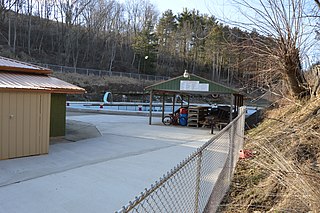
Cameron City Pool-PWA Project 1196 is a historic swimming pool located at Cameron, Marshall County, West Virginia. It was built in 1939, with a grant from the Public Works Administration. It consists of a semi-circular pool with underwater lifeguard station, and a wooden bath house. It incorporates a beach area and is recognized as a potential fire fighting emergency water reserve.
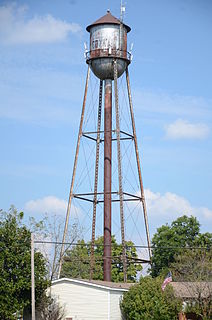
The Cotter water tower is a historic elevated steel water tower located in Cotter, Arkansas. It was constructed in 1935 by the Pittsburgh-Des Moines Steel Company, as part of the development of the local water supply system by the Public Works Administration. The tower was added to the National Register of Historic Places in 2007, as part of a multiple-property listing that included numerous other PWA-era projects in Arkansas, under the heading “An Ambition to Be Preferred: New Deal Recovery Efforts and Architecture in Arkansas, 1933-1943.”

The Monette Water Tower is a historic elevated steel water tower located in Hartford, Arkansas. It was built in 1936 by the Chicago Bridge & Iron Company in conjunction with the Public Works Administration as part of a project to improve the local water supply. The project was one of 124 similar projects in the state funded by the PWA. It was added to the National Register of Historic Places in 2008, as part of a multiple-property listing that included numerous other New Deal-era projects throughout Arkansas.
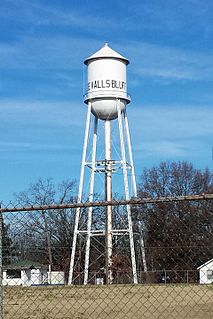
The De Valls Bluff Waterworks is a historic public water supply facility at Rumbaugh and Hazel Streets in De Valls Bluff, Arkansas. It contains a 1930s-era elevated steel water tower, built in 1936 by the Pittsburgh-Des Moines Steel Company in conjunction with the Public Works Administration as part of a project to improve the local water supply. It was added to the National Register of Historic Places in 2007, as part of a multiple-property listing that included numerous other New Deal-era projects throughout Arkansas. The property also contains several non-contributing buildings, including a shed, aeration chamber and water tank.

The Cross and Nelson Hall Historic District encompasses two historic buildings on the campus of Southern Arkansas University in Magnolia, Arkansas. Cross Hall and Nelson Hall were both built in 1936 by the Public Works Administration (PWA) as dormitories for boys and girls, respectively. They are two-story L-shaped brick buildings with Colonial Revival and Collegiate Gothic stylistic elements. Cross Hall has since been converted into classrooms and professors' offices; Nelson Hall now houses student services and the admissions office.
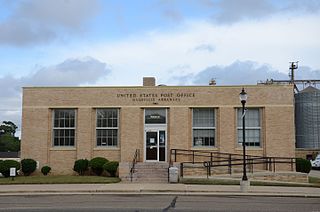
The Nashville Post Office is a historic post office building located at 220 North Main Street in Nashville, Howard County, Arkansas.

The Keiser Water Tower is a historic waterworks facility at Water and East Main Street in Keiser, Arkansas. It is an open metal structure, several stories high, with a roughly cylindrical tank at the top, and a rising through the center to provide water to the tank. A ladder providing access to the tank is fixed to one of the legs, and there is a circular catwalk with railing around the tank. The structure was built in 1936 with funding from the Public Works Administration, and is one of the few Depression-era structures left in the small community.

The Green Forest Water Tower is a historic water tower, located near the junction of South Springfield and East Second Streets in Green Forest, Arkansas. It consists of a metal supporting structure with four legs and cross bracing, supporting a water tank with a bowl-shaped bottom, with a water pipe in the center of the structure connecting the tank to the water system. The tank was built in 1937 by the Chicago Bridge and Iron Works Company with funding from the Public Works Administration. It is the only known surviving PWA-funded tower in Carroll County.

The Tuckerman Water Tower is a historic waterworks facility at the south end of Front Street in Tuckerman, Arkansas. It is a tall metal structure, with four latticed legs, braced with rods and sloping inward, to support a water tank that is bowl-shaped at the bottom and topped by a conical roof. A pipe traverses the center of the tower for the movement of water to and from the tank. Built in 1935 with funding support from the Depression-era Public Works Administration (PWA), it is the only remaining PWA tower of its type in the county.

The Park Hill Fire Station and Water Company Complex is a collection of historic public facilities at 3417-21 Magnolia Street in North Little Rock, Arkansas. The complex consists of a fire station, a water company office, two concrete reservoirs, and two stone pump houses, all built in 1938 with funding support from the Works Progress Administration. The fire station and water company office are distinguished architecturally by their fieldstone exteriors and Mediterranean style, including red tiled roofs. They were designed by the Little Rock firm of Brueggeman, Swaim and Allen.

The Russellville Public Library is the public library serving Russellville, Arkansas. It is a branch of the Pope County Library system. It is located at 116 East Third Street.
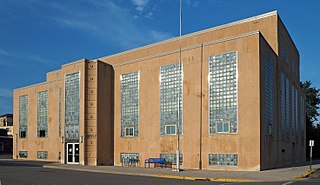
The Ely Community Center is a historic municipal building in Ely, Minnesota, United States. It was built in 1938 with funding assistance from the Public Works Administration, one of many New Deal projects designed to provide both short-term employment and lasting benefits to a community. The Ely Community Center initially housed the public library, an auditorium, meeting rooms, and offices, as well as a cafeteria and public showers. The building's design mixed Art Deco with restrained Neoclassical formalism, a style that came to be known as PWA Moderne.





















